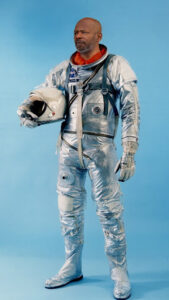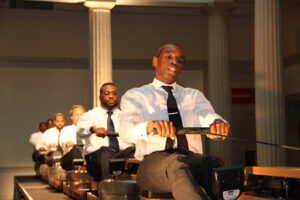Jefferson Pinder was getting his BA in Theatre when he visited a video art exhibition by Gary Hill and realized the strength of using video as an art medium. He’d always loved performance art because of the community it created between the artist and the audience, and video was the perfect way for him to do that.
Pinder’s first source of inspiration for his work came from the University of Maryland’s campus. Many students had joked about how it looked like a plantation, but upon researching, he realized that it actually was. According to the University’s website, the Riverside Plantation was converted into a school in 1856, the first six of its presidents were Confederate Officers.

Photo Credit: jeffersonpinder.com
Through learning the history of his home, and inspiration from his mentor David Driskel, Pinder began creating videos in 1999. His art is not only focused on the African American experience but largely on the performers pushing themselves to their physical limits.
His collection that was on display in WCU’s Bardo Arts Center titled ‘Jefferson Pinder: Selections from the Inertia Cycle, 2003-2014,’ showcased five of his best videos: Marathon, Mule, Lazarus, Ben Hur, and Thoroughbred. Pinder highlights physical exertion to the point of collapse in his work because of how rare it is to see another person working out – and what can be learned from it.
Thoroughbred shows four performers, two men and two women all POC, running on treadmills while naked. At the back of the room was Pinder, who had switches to control the speed of the treadmills. Every few minutes he would increase the speed until all of the runners could not continue.
At first glance, his projects can seem jarring. That it’s a testament to the tragic history of African Americans, but that isn’t exactly Pinder’s intention. He doesn’t consider his work to be activistic because that wasn’t his goal when creating his projects, though he does happily accept the title. Pinder likes showcasing intense physical exertion and the point of collapse because of the self-learning that comes from it, and the metaphors for social struggles within them.
Everyone pushes themselves, and it is going to inevitably lead to an unpredictable breakdown. Pinder believes that we all carry so much history and heritage in our bodies, and that factors into how long we can continue before we have to stop. His use of African American performers is to speak on their history in a subtle way, within the length of time before their collapse.

Photo Credit: jeffersonpinder.com
Pinder has received quite a few rewards for his work, including the Joyce Fellowship award in 2016 in the field of performance, a Guggenheim fellowship in 2017, and this year Pinder was named a Smithsonian Artist Research Fellow.
Guest Curator Julie Levin Caro, Professor of Art History and Faculty Director of Craft Studies at Warren Wilson College, and Pinder were excited to bring his work to an academic setting. His work has been displayed all over the world, from Tate Modern in London to the 2016 Shanghai Biennial, but bringing it to a university was a new experience.
Their original plan was to project the videos as life-sized, but they ended up having to project them much bigger which Caro said was a very happy accident because of the immersive experience it created for its viewers. “It sort of brings you in and enhances what the videos do. They really encourage you to connect and to empathize with the figures as they sort of move through these grueling exercises,” Caro said.
Pinder’s work remained on display in WCU’s Fine Art Museum for all to experience until Oct 22 and can now be viewed on his website, jeffersonpinder.com.






